Abstract
Recent advances in sensor technology, wireless communication, and hand held computing devices enable location-aware services and agents that provide appropriate information and services depending on the location of the user. To provide better quality services, it is required to know and predict accurately the behavior of the user based on the data acquired from the sensors. We propose a method to estimate the arrival time of pedestrian using walking logs obtained by the GPS and stored in a database. It can be applied for pedestrian navigation and just-in-time information retrieval with high accuracy. The method retrieves walking trajectories similar to the user’s one from the database and estimates the arrival time to her destination. In the evaluation experiment, we collected walking trajectories of pedestrians who walked the same route, and compared our method with conventional ones based on the average arrival time and the extrapolation method. As a result, the estimation error of our method was smaller than that of the conventional ones. In particular, our method shows a better estimation for a route that includes a slope where the walking pattern of pedestrians drastically change.
Access this chapter
Tax calculation will be finalised at checkout
Purchases are for personal use only
Preview
Unable to display preview. Download preview PDF.
References
Kaasinen, E.: User needs for location-aware mobile services. Personal and Ubiquitous Computing 7(1), 70–79 (2003)
Lee, J., Mateo, R.M.A., Gerardo, B.D., Go, S.-H.: Location-aware agent using data mining for the distributed location-based services. In: Gavrilova, M.L., Gervasi, O., Kumar, V., Tan, C.J.K., Taniar, D., Laganá, A., Mun, Y., Choo, H. (eds.) ICCSA 2006. LNCS, vol. 3984, pp. 867–876. Springer, Heidelberg (2006)
Fujita, Y., Nawaoka, T., Hirohata, E.: Development of a mapping and guidance database for automobile navigation system. In: Proceedings of the 41st IEEE Vehicular Technology Conference, pp. 869–874. IEEE (1991)
Arikawa, M., Konomi, S., Ohnishi, K.: NAVITIME: Supporting pedestrian navigation in the real world. IEEE Pervasive Computing 6(3), 21–29 (2007)
Cheverst, K., Davies, N., Mitchell, K., Friday, A., Efstratiou, C.: Developing a context-aware electronic tourist guide: some issues and experiences. In: Proceedings of the SIGCHI Conference on Human Factors in Computing Systems, pp. 17–24. ACM (2000)
Bieber, G., Giersich, M.: Personal mobile navigation systems – design considerations and experiences. Computers & Graphics 25(4), 563–570 (2001)
Fano, A.E.: Shopper’s eye: using location-based filtering for a shopping agent in the physical world. In: Proceedings of the 2nd International Conference on Autonomous Agents, pp. 416–421. ACM (1998)
Rhodes, B.: Using physical context for just-in-time information retrieval. IEEE Transactions on Computers 52(8), 1011–1014 (2003)
Liao, L., Patterson, D.J., Fox, D., Kautz, H.: Learning and inferring transportation routines. Artificial Intelligence 171(5), 311–331 (2007)
Ashbrook, D., Starner, T.: Using GPS to learn significant locations and predict movement across multiple users. Personal and Ubiquitous Computing 7(5), 275–286 (2003)
Liao, L.: Location-based activity recognition. PhD thesis, University of Washington (2006)
Bui, H.H., Venkatesh, S., West, G.: Policy recognition in the abstract hidden Markov model. JournalofArtificial Inteligence Research 17, 451–499 (2002)
Rice, J., Van Zwet, E.: A simple and effective method for predicting travel times on freeways. IEEE Transactions on Intelligent Transportation Systems 5(3), 200–207 (2004)
Lin, H.-E., Zito, R., Taylor, M.A.: A review of travel-time prediction in transport and logistics. In: Proceedings of the Eastern Asia Society for Transportation Studies, vol. 5, pp. 1433–1448 (2005)
Trajcevski, G., Wolfson, O., Hinrichs, K., Chamberlain, S.: Managing uncertainty in moving objects databases. ACM Transactions on Database Systems (TODS) 29(3), 463–507 (2004)
Jula, H., Dessouky, M., Ioannou, P.A.: Real-time estimation of travel times along the arcs and arrival times at the nodes of dynamic stochastic networks. IEEE Transactions on Intelligent Transportation Systems 9(1), 97–110 (2008)
Author information
Authors and Affiliations
Editor information
Editors and Affiliations
Rights and permissions
Copyright information
© 2013 Springer-Verlag Berlin Heidelberg
About this paper
Cite this paper
Okuda, Y., Kitamura, Y. (2013). Estimating Arrival Time of Pedestrian Using Walking Logs. In: Boella, G., Elkind, E., Savarimuthu, B.T.R., Dignum, F., Purvis, M.K. (eds) PRIMA 2013: Principles and Practice of Multi-Agent Systems. PRIMA 2013. Lecture Notes in Computer Science(), vol 8291. Springer, Berlin, Heidelberg. https://doi.org/10.1007/978-3-642-44927-7_39
Download citation
DOI: https://doi.org/10.1007/978-3-642-44927-7_39
Publisher Name: Springer, Berlin, Heidelberg
Print ISBN: 978-3-642-44926-0
Online ISBN: 978-3-642-44927-7
eBook Packages: Computer ScienceComputer Science (R0)

